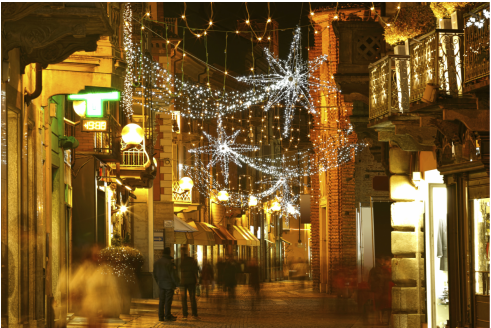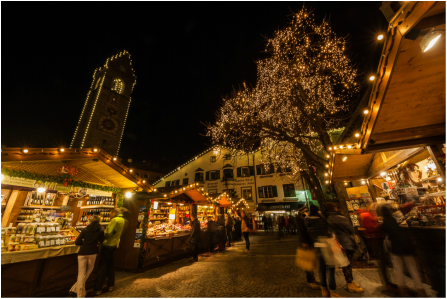 Always attempting to improve my mastery of the Italian language, I am again enrolled in a language class. Before the Holiday break, our teacher, Michela, described some of the Christmas and New Year’s traditions observed in her native Italy. My interest was piqued and I wanted to learn more. Here are some of my favorites, beginning with a list of the special days celebrated in Italy during this time of year: December 8 the celebration of L’Immacolata Concezione (the Immaculate Conception) December 13 La Festa di Santa Lucia December 24 La Vigilia di Natale (Christmas Eve) December 25 Natale (Christmas) December 26 La Festa di Santo (marks the announcement of the birth of Jesus and the arrival of the Wise Men (Mostrarmi) December 31 La Festa di San Silvestro or La vigilia di Capodanno (New Year’s Eve) January 1 Il Capodanno (New Year’s Day) January 6 La Festa dell Epifania (The Epiphany). Gift giving and preparing for the New Year involves many traditions, many of which can be traced back to the ancient Romans. Some are celebrated throughout Italy and others are particular to different regions of the country. I am particularly fond of the tradition of children writing letters to tell their parents how much they love them. The letter(s) are normally placed under the father’s plate and read when dinner is finished on Christmas Eve. The Tree of Light is a wooden frame in the shape of a pyramid with several tiers of shelves decorated with a Nativity Scene, colored paper, gilt pine cones and miniature colored pennants with candles attached to the sides and a star or small doll at the apex. The Urn of Fate is filled with small gifts and the family takes turns drawing out a gift until all gifts are gone. On the Feast of Epiphany (Jan 6) La Befana (a kindly witch) brings toys to the children and sometimes a piece of coal that is actually, nowadays, carbon dolce (rock candy that looks amazingly like coal). The New Year (“Capodanno”) involves a variety of customs primarily having to do with throwing out the old and preparing for the new. On the last day of the year a Yule Log is kept burning to keep evil spirits at bay because these nasty spirits don’t like fire. Likewise, the elaborate fireworks displays on New Year’s Eve keeps those same spirits away because they don’t like loud noise either. In southern Italy, especially in Naples, old pots, pans, clothing and even appliances and furniture are thrown out the windows to represent “letting go” of the past and preparing for the future. Old crockery is also thrown out at midnight (“lancio dei cocci”), specifically from the sitting room window and even inside. Be careful where you walk if you are in Naples this time of year. Wearing new, red undergarments on New Year’s Eve brings luck. These must be given as a gift and thrown away after January 1st for the power against evil spirits to be effective. For centuries red has been used to exorcise war and catastrophes. Le Strenne are simple gifts that are given at New Years. This tradition can be traced back to the ancient Romans giving gifts to each other to increase well being and good luck for the New Year. Kissing under the mistletoe on New Year’s Eve is a tradition traced to ancient times when this plant was thought to be magical with the ability to induce fertility and love. Eating grapes at midnight on New Year’s Eve is a relatively newer tradition traced to the Iberian Peninsula and introduced in Italy by the Spaniards. At midnight people offer each other twelve grapes, each symbolizes a golden coin for each of the twelve months of the year and represents abundance, fertility, plenty and good luck. The game of Tombola (similar to lotto) is traditionally played on New Year’s Eve. This game was introduced to take the place of gambling in the 18th century. Although legal in Naples (it was a source of revenue for the Kingdom of Naples), gambling was not tolerated by the church for moral reasons. Doors and windows are kept open on New Year’s Day to let in good spirits and to create a draft to blow the evil spirits away. Food, of course, is an important component in the Italian Holiday Season. Pesce (fish) is served for cena (dinner) on Christmas Eve. On December 25th pranzo (lunch) is the important meal and traditional foods are served depending on the region. For La Sera di Capodanno (New Year’s Eve), there is a cenone or grande cena (elaborate dinner). Throughout Italy, Lentichie (lentils) are served and represent money and good luck. Figs and figs in honey are eaten in Naples to ensure a sweet new year and a bay branch for good fortune, both traditions still done as in ancient Roman times. I hope you have enjoyed this peak into the Holidays as celebrated in my favorite European country—Italy! Buon Anno a tutti and I wish you a Happy and Healthy 2016! Saluti Cordiali, Andrea Aldrich Travel in Italia, Small Group Tours of Italy
0 Comments
|
Andrea Aldrich
I am an artist, teacher and avid traveler. I love to share with like-minded individuals my favorite European country— Italy. Archives
April 2020
Categories |


 RSS Feed
RSS Feed
